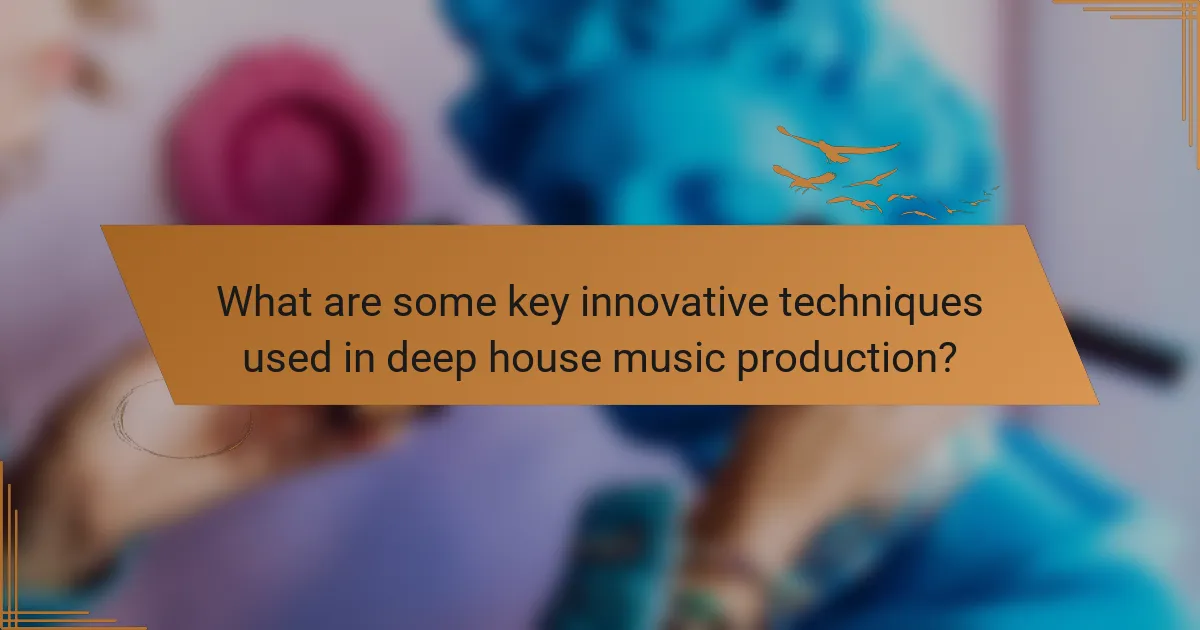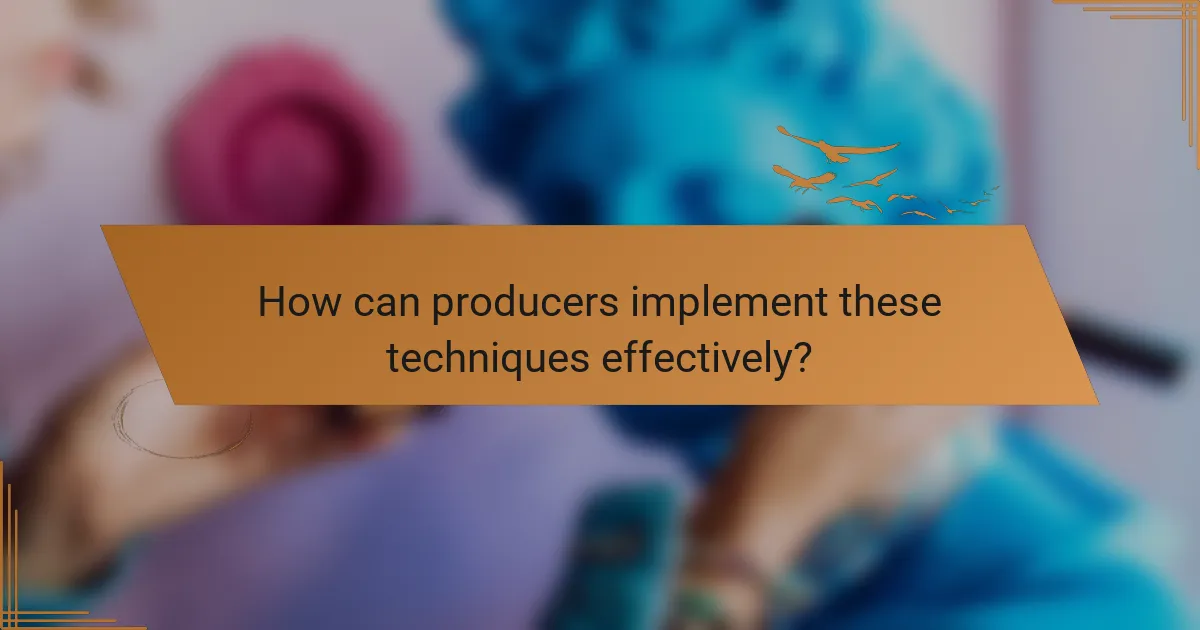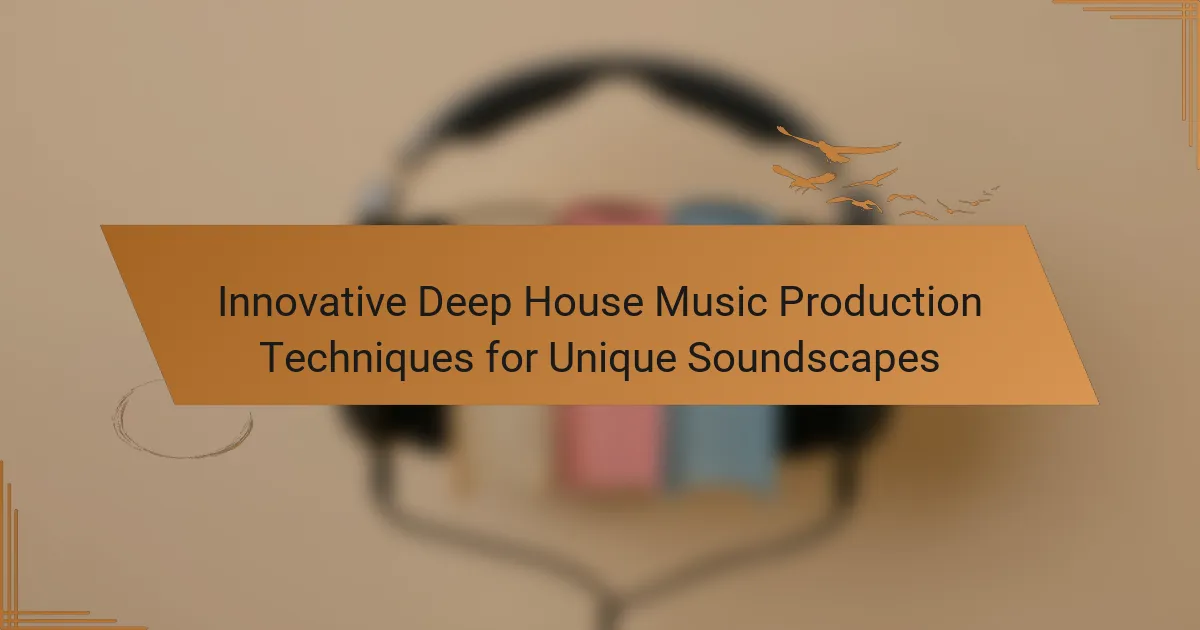Innovative deep house music production techniques focus on creating unique soundscapes through methods such as layering sounds, utilizing unique samples, and experimenting with effects. Key techniques include sidechain compression for rhythmic pulse, modulation for dynamic sound movement, and atmospheric pads for depth. Producers can enhance their tracks by exploring digital audio workstations (DAWs) like Ableton Live or FL Studio, which provide essential features for sound design. Continuous experimentation with sound selection and field recordings contributes to the originality and richness of deep house music. Engaging with online resources further supports producers in staying current with trends and techniques in the genre.

What are Innovative Deep House Music Production Techniques?
Innovative deep house music production techniques include layering sounds, utilizing unique samples, and experimenting with effects. Layering involves combining multiple synths or samples to create a rich texture. Unique samples can be sourced from field recordings or unconventional instruments to add originality. Effects such as reverb, delay, and modulation enhance depth and atmosphere. Sidechain compression is commonly used to create a pumping effect, essential in deep house. Additionally, using automation for dynamic changes throughout the track keeps the listener engaged. Techniques like vocal chops and granular synthesis can introduce unexpected elements. These methods collectively contribute to the distinctive soundscapes characteristic of innovative deep house music.
How do these techniques differ from traditional production methods?
Innovative deep house music production techniques differ from traditional production methods primarily in their use of technology and sound design. These techniques often incorporate advanced digital audio workstations (DAWs) and plugins. Traditional methods typically relied on analog equipment and live recordings. Innovative techniques emphasize layering sounds and using samples creatively, while traditional methods focused on live instrumentation. Furthermore, innovative methods often utilize automation and modulation to create dynamic soundscapes. This contrasts with traditional methods, which may have limited flexibility in sound manipulation. The result is a more experimental and diverse sonic palette in innovative deep house music production.
What specific elements define innovative techniques in deep house music?
Innovative techniques in deep house music are defined by unique sound design, complex rhythms, and atmospheric elements. Unique sound design incorporates unconventional samples and synthesizers. This can include organic sounds, vocal chops, and intricate textures. Complex rhythms often feature syncopated beats and polyrhythms, creating a dynamic groove. Atmospheric elements include ambient pads and reverb effects, enhancing the overall depth of the track. Additionally, the use of automation in mixing adds movement and variation. These elements contribute to a distinct and immersive listening experience, setting innovative deep house apart from traditional forms.
How have advancements in technology influenced these production techniques?
Advancements in technology have significantly influenced deep house music production techniques. Digital audio workstations (DAWs) have streamlined the production process. These platforms allow for easier manipulation of sound and layering of tracks. Software synthesizers have expanded the range of sounds available to producers. This has enabled the creation of unique soundscapes that define deep house music. Additionally, advancements in MIDI technology allow for precise control over musical elements. The use of plugins has enhanced audio quality and introduced innovative effects. Furthermore, online collaboration tools have facilitated teamwork among producers globally. These technological developments have transformed the landscape of music production, making it more accessible and creative.
Why is creating unique soundscapes important in deep house music?
Creating unique soundscapes is important in deep house music because they enhance the listening experience. Unique soundscapes provide depth and texture to tracks. They differentiate one artist’s work from another. This distinctiveness is crucial in a genre saturated with similar beats. Unique soundscapes can evoke specific emotions and atmospheres. They contribute to the storytelling aspect of a track. Engaging soundscapes can captivate audiences during live performances. Ultimately, they help artists establish their identity in the competitive music scene.
What role do soundscapes play in the overall listening experience?
Soundscapes significantly enhance the overall listening experience. They provide an immersive auditory environment that engages listeners on multiple levels. Soundscapes can evoke emotions and set moods, making music more impactful. They also create a sense of space and depth, allowing listeners to feel as though they are part of the sound. Research indicates that well-crafted soundscapes can improve listener retention and enjoyment. For instance, studies show that soundscapes in music can increase listener engagement by up to 30%. This demonstrates their essential role in music production, particularly in genres like deep house.
How can unique soundscapes enhance emotional connections with listeners?
Unique soundscapes can enhance emotional connections with listeners by creating immersive auditory experiences. These soundscapes evoke specific feelings and memories through their distinct textures and layers. For example, nature sounds can promote relaxation and nostalgia. Research shows that music with unique soundscapes can trigger emotional responses due to its ability to engage the brain’s limbic system. A study published in the Journal of Music Therapy found that participants reported heightened emotional states when exposed to varied soundscapes. This indicates that unique soundscapes play a crucial role in deepening listener engagement and emotional resonance.

What are some key innovative techniques used in deep house music production?
Key innovative techniques in deep house music production include sampling, sidechain compression, and modulation. Sampling allows producers to incorporate unique sounds and textures into their tracks. Sidechain compression creates a pumping effect, enhancing the rhythm and groove. Modulation adds depth and movement to sounds, making them more dynamic. Additionally, the use of atmospheric pads and lush synths contributes to the genre’s signature sound. Effects like reverb and delay are also crucial for creating spacious soundscapes. These techniques collectively help define the innovative nature of deep house music production.
How can layering sounds contribute to a unique soundscape?
Layering sounds contributes to a unique soundscape by combining multiple audio elements to create depth and texture. This technique enhances the overall auditory experience. Each layer can introduce distinct tonal qualities and rhythms. For example, a deep bass line can be layered with melodic synths and vocal samples. This combination can evoke specific emotions and atmospheres. Research shows that complex soundscapes engage listeners more effectively than simple ones. According to a study by the Journal of New Music Research, layered sounds can significantly increase listener immersion. Thus, layering is essential in producing innovative deep house music.
What types of sounds are most effective for layering in deep house?
Percussive sounds are most effective for layering in deep house. These include claps, snares, and hi-hats. Bass sounds also play a crucial role, providing depth and groove. Synth pads create atmospheric layers that enhance the overall sound. Vocal samples can add a unique texture and emotional element. Ambient sounds contribute to the richness of the mix. Each of these sound types complements the others, creating a cohesive and immersive experience. Layering these elements effectively results in a well-rounded deep house track.
How does the choice of instruments affect the layering process?
The choice of instruments significantly influences the layering process in music production. Different instruments contribute unique timbres and textures to a track. For example, synthesizers can create rich, complex sounds that add depth. Acoustic instruments, like guitars or pianos, provide warmth and authenticity. The combination of these elements can enhance the overall soundscape. Layering different instrument types allows for a more dynamic mix. It also helps to create contrast and interest in the arrangement. Therefore, selecting instruments carefully is crucial for achieving desired sonic outcomes.
What is the significance of sound design in deep house music?
Sound design is crucial in deep house music. It shapes the overall atmosphere and emotional impact of the tracks. Unique sounds create immersive experiences for listeners. Layering techniques enhance depth and complexity in the music. The use of various effects adds texture and richness. High-quality samples contribute to a polished sound. Innovative sound design distinguishes artists in a competitive genre. Ultimately, it influences listener engagement and enjoyment.
How can synthesizers be used creatively in sound design?
Synthesizers can be used creatively in sound design by generating unique sounds and textures. They offer a wide range of waveforms, modulation options, and effects. This versatility allows sound designers to craft distinctive sonic landscapes. For example, subtractive synthesis can shape complex sounds from simple waveforms. Additionally, additive synthesis builds sounds by layering harmonics. Using filters and envelopes further enhances sound manipulation. Modulation sources, like LFOs, create movement and dynamics in sounds. By experimenting with different parameters, designers can achieve innovative results. This creative freedom is essential in deep house music production.
What techniques can be applied to create unique synth sounds?
Modulation techniques can be applied to create unique synth sounds. These techniques include frequency modulation (FM), amplitude modulation (AM), and ring modulation. FM synthesis alters the frequency of one oscillator with another. This creates complex harmonic structures. AM synthesis varies the amplitude of a waveform over time. It can produce dynamic sound textures. Ring modulation combines two signals to generate new frequencies. This results in metallic or bell-like tones.
Layering different synth sounds enhances uniqueness. Combining multiple oscillators can create richer textures. Using different waveforms, such as sawtooth, square, and sine, adds diversity. Applying effects like reverb, delay, and distortion further shapes the sound. Each effect contributes distinct characteristics to the final output.
Sound design techniques also play a crucial role. Creating custom waveforms or samples allows for originality. Utilizing granular synthesis can transform sounds into entirely new textures. Additionally, experimenting with unconventional scales and tuning systems can yield unique melodic outcomes.

How can producers implement these techniques effectively?
Producers can implement innovative deep house music production techniques effectively by utilizing specific software tools and sound design methods. First, they should explore digital audio workstations (DAWs) like Ableton Live or FL Studio for their flexibility. These DAWs offer features such as automation, MIDI manipulation, and audio effects, which are essential for creating unique soundscapes.
Next, producers should incorporate layered sounds to build depth. This involves combining various synths and samples to enrich the overall texture. Using techniques like sidechain compression can help achieve a rhythmic pulse, which is crucial in deep house music.
Additionally, experimenting with field recordings can introduce organic elements. Capturing ambient sounds from different environments adds a unique character to tracks.
Producers should also focus on sound selection. Choosing high-quality samples and synth presets can significantly enhance the final mix.
Finally, continuous learning and experimentation are vital. Engaging with online tutorials and communities can provide new insights and inspiration. This approach allows producers to stay updated on current trends and techniques in deep house music.
What software and tools are essential for innovative deep house production?
Essential software and tools for innovative deep house production include Digital Audio Workstations (DAWs), synthesizers, and audio plugins. Popular DAWs like Ableton Live and FL Studio provide versatile platforms for music creation. Synthesizers such as Serum and Massive are crucial for crafting unique sounds. Audio plugins like iZotope Ozone and Waves provide essential mixing and mastering capabilities. These tools enable producers to experiment with sound design and create distinctive deep house tracks. The combination of these software and tools is widely recognized in the music production community for their effectiveness in achieving innovative soundscapes.
How do different DAWs compare for deep house music production?
Different DAWs have unique strengths for deep house music production. Ableton Live is favored for its intuitive workflow and session view, which allows for easy arrangement and experimentation. FL Studio is known for its powerful piano roll and automation features, making it ideal for intricate melodies and effects. Logic Pro X offers a comprehensive suite of built-in instruments and effects, enhancing sound design capabilities. Cubase excels in MIDI editing and audio quantization, providing precision for complex arrangements. Each DAW supports VST plugins, enabling access to a wide range of sounds. The choice of DAW ultimately depends on personal workflow preferences and specific production needs.
What plugins are recommended for achieving unique soundscapes?
Valhalla Shimmer, Soundtoys EchoBoy, and Native Instruments Kontakt are recommended plugins for achieving unique soundscapes. Valhalla Shimmer creates lush reverb effects, enhancing spatial depth. Soundtoys EchoBoy offers versatile delay options, contributing to rhythmic complexity. Native Instruments Kontakt provides extensive sample manipulation capabilities, allowing for creative sound design. These plugins are widely used in deep house music production for their ability to generate immersive auditory experiences.
What are some best practices for mixing and mastering deep house tracks?
Use proper EQ to carve out space for each element in deep house tracks. Focus on removing unnecessary frequencies to avoid muddiness. Apply compression to maintain dynamic control, ensuring the elements blend seamlessly. Utilize reverb and delay to create depth and atmosphere, enhancing the overall vibe. Balance levels carefully to ensure clarity and presence of all instruments. Use automation to add movement and interest throughout the track. Mastering should enhance loudness while preserving dynamics, targeting a loudness level around -14 LUFS for streaming platforms. Finally, reference your mix against professional tracks to gauge quality and make necessary adjustments.
How can EQ and compression be used to enhance sound clarity?
EQ and compression enhance sound clarity by shaping frequency balance and controlling dynamic range. EQ, or equalization, adjusts specific frequency bands. This process removes unwanted frequencies and boosts essential ones. For example, cutting low frequencies can reduce muddiness. Boosting mid and high frequencies can bring vocals and instruments forward in the mix.
Compression controls the dynamic range of a sound. It reduces the volume of the loudest parts while boosting quieter sections. This creates a more consistent sound level. A well-compressed track can prevent sounds from being lost in the mix.
Using both tools together improves overall clarity. EQ can make space for sounds, while compression ensures they are heard clearly. This combination is essential in deep house music production for achieving a polished sound.
What tips can help achieve a balanced mix in deep house music?
To achieve a balanced mix in deep house music, focus on proper EQing, leveling, and panning. Start by using equalization to carve out space for each element. This ensures that frequencies do not clash. Leveling should be done carefully to maintain the presence of all instruments and vocals. Use faders to adjust volumes so that no single element overwhelms the mix. Panning helps create a stereo image, giving each sound its own space. Ensure that bass elements are centered for a solid foundation. Use reference tracks to compare your mix against professional standards. This helps identify any imbalances. Lastly, take breaks during mixing sessions to maintain perspective on the sound. This can lead to a more objective assessment of the mix.
What common challenges do producers face when creating unique soundscapes?
Producers face several common challenges when creating unique soundscapes. One significant challenge is the complexity of sound layering. Balancing multiple sounds can lead to a cluttered mix. Another challenge is achieving originality. Many producers struggle to create distinctive sounds that stand out. Technical limitations also pose issues. Hardware and software constraints can restrict creative possibilities. Additionally, producers often encounter difficulties in sound design. Crafting unique textures requires extensive knowledge of synthesis and sampling techniques. Lastly, time management is crucial. Producers may find it hard to allocate sufficient time for experimentation and refinement. These challenges are well-documented in music production literature, highlighting their prevalence in the industry.
How can producers overcome creative blocks in the production process?
Producers can overcome creative blocks in the production process by implementing structured techniques. One effective method is to take breaks to refresh the mind. Research indicates that stepping away can enhance creativity. Another approach is to change the environment, which can inspire new ideas. Collaborating with other artists can also provide fresh perspectives. Techniques such as brainstorming or mind mapping can stimulate creative thought. Additionally, setting specific goals can help maintain focus. Using creative prompts or challenges can push producers to think outside the box. Lastly, exploring different musical genres may spark new inspiration.
What troubleshooting steps can be taken when sounds clash in a mix?
Identify conflicting sounds in the mix. Use frequency analysis tools to visualize overlapping frequencies. Adjust the EQ settings to carve out space for each sound. Apply panning techniques to separate sounds in the stereo field. Utilize volume adjustments to balance the levels of clashing sounds. Experiment with dynamic processing, such as compression, to control peaks. Consider layering sounds differently or using sound design techniques to create distinct textures. Regularly reference the mix on different playback systems to ensure clarity across environments.
Innovative deep house music production techniques focus on creating unique soundscapes through advanced sound design and technology. Key methods include layering sounds, utilizing unique samples, and implementing effects like reverb and sidechain compression. These techniques differ from traditional methods by emphasizing digital tools and creative manipulation of sounds. The article explores specific elements that define innovative deep house, the influence of technology on production, and best practices for mixing and mastering tracks to enhance listener engagement and emotional connection.
